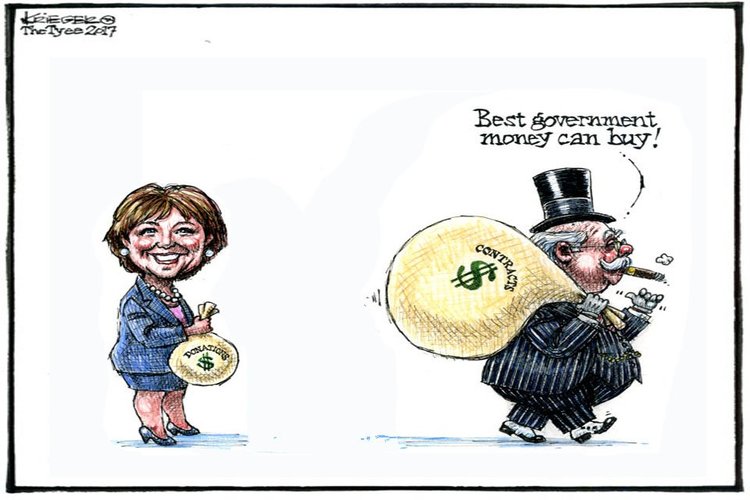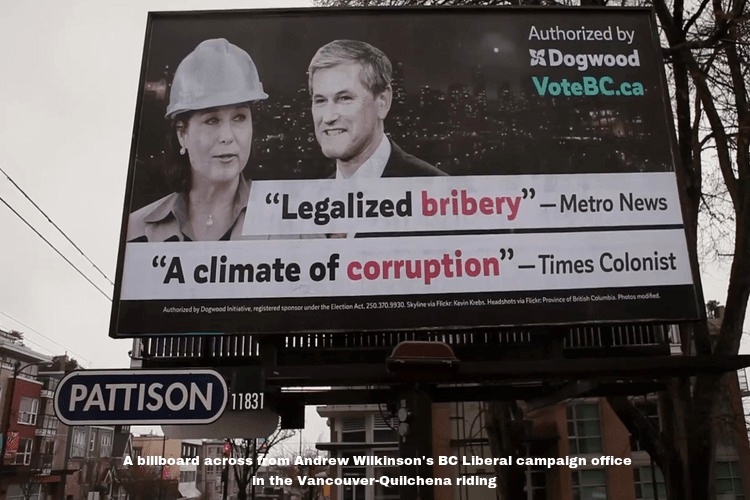
| Cumulative loss (est.) of BC Conservative Party membership fee revenue over the past 10 years | = | |
| Cumulative loss (est.) of BC Conservative Party fundraising revenue over the past 10 years | = | $50M – $110M
|
| QUESTION: Where did our money go? | ||
| ANSWER: Most of our money has gone to the BC Liberals and BC NDP. | ||
| EXPLANATION: | ||
|
||
Election Platform
To fix three problems preventing the BC Conservative Party from winning elections. These problems and their solutions include:
- Money Drives Election Outcomes
- The Great BC Liberal Wall
- The Wall Is Expanding
- Going Over The Wall
- What Democracy Looks Like
- Ms. Clark, “Tear Down This Wall”
- Fortifying the Great Wall
- Confronting Ozymandias
- Provincial Capture Vs. Clean Government
- Walls Get Built When Good People Do Nothing
- The Great BC Liberal Wall Is The Enemy of Freedom and Democracy
Problem 1: Our Party is underfinanced
- Money may be driving election outcomes.
- The BC Conservative Party has limited funds.
Money Drives Election Outcomes.
The more money a political party spends in an election, the better it performs on Election Day.
The evidence for this is at the party and candidate levels.
At the level of the party in the 2013 BC general election, Elections BC data suggests that the number of seats that a Party wins may be related to how much it spends. The Table below shows that the BC Liberals outspent the BC NDP by 23% and won 31% more seats.
| Party | Income | Expenditure | Seats Won |
|---|---|---|---|
| BC Liberals | 8,560,799 | 11,740,241 | 49 |
| BC NDP | 9,661,582 | 9,090,490 | 34 |
| BC Conservatives | 178,267 | 154,502 | 0 |
| Data Source: Elections BC | |||
At the level of the candidate in the 2013 BC general election, Elections BC data show that vote share (%) in a riding increases with election spending. The scatterplot below plots candidate vote share (%) against candidate election expenses. The All Candidates Trend Line is based mainly on Liberal, NDP and Green candidates. From 0 to $100,000, the slope of the All Candidates Trend Line is positive and relatively linear. For every $1,000 spent by a candidate, the vote share of that candidate climbs 0.52%. After $100,000, the slope decreases. For every $1,000 spent by a candidate, the vote share increases by only 0.13%. Thus, candidates must spend 3–4 times more money to capture the same level of vote share after already committing $100,000 to their campaign.

-
The Great BC Liberal Wall.
A majority of Conservative candidate data points in the scatterplot (above) fall below the All Candidates Trend Line. The location of the data on the graph, the comparatively few Conservative data points after $50,000, and the decreased slope of the Conservative Candidates Trend Line relative to the main trend suggests the presence of a great wall in the way of Conservative candidates winning elections. The size of the wall is revealed by comparing the effects of election costs on vote shares for Liberal and Conservative candidates. Liberal candidates that spend $90,000 during the 2013 BC general election will capture 47% of the vote share. By contrast, assuming the linear Conservative Candidate Trend Line continues beyond the known data, Conservative candidates that spend the same amount will capture only 15.2% of the vote share. To acquire the same 47% vote share as the Liberal candidates, Conservative candidates must spend over $400,000 on their election campaigns, that is, over four times what Liberal candidates spend and over thirty times what the average Conservative candidate spends ($13,284) during the 2013 BC general election. The Wall for BC Conservatives is inordinately tall and wide. It is a repressive structure developed for the purpose of excluding ideas and minimizing the exchange of knowledge. In a free and democratic society like the one we have in BC, the Great BC Liberal Wall is hypocrisy.
[The idea that some institutions or structures are hypocrisies is based on a famous speech given by the African American statesman, Frederick Douglass, on July 4th, 1852 in Rochester, New York.]
| Election Result | Number of Candidates | Average Expenditure |
|---|---|---|
| Winner | 85 | 98,599 |
| 1st runner–up | 85 | 65,467 |
| 2nd runner–up | 84 | 13,932 |
| Data Source: Elections BC | ||
-
The Wall Is Expanding.
In 2014, the BC Liberal Party's annual income was $10,430,430, over 120 times that collected by the BC Conservative Party ($85,731). In 2015, the BC Liberal Party annual income was $10,359,622, over 170 times the income of the BC Conservative Party ($59,400). According to the BC Liberal Party website, the Party raised $12,474,088 in 2016.
-
Going Over The Wall.
The BC Conservatives fielded 56 of 85 possible candidates in the 2013 BC general election. With money and a lot of hard work, the BC Conservatives could have won the election by winning 30 of the 56 ridings with a minimum of 232,892 more votes in addition to the 43,023 votes already captured by Conservative candidates. These additional votes could have come from the 457,558 registered voters in the 30 ridings who did not vote in the election.
-
What Democracy Looks Like.
According to Elections Canada, an important pillar of electoral democracy is the idea that elections should be fair. Elections BC, an independent, non-partisan agency that reports directly to the BC Legislature, defines fairness as "Fairness: money should not unduly influence the outcome of an election." The scatterplot below plots candidate vote share (%) against candidate election expenses for a fair election based on Elections BC standards. We created the plot by randomly assigning 2013 BC general election vote share values to candidates within ridings (approximately 1.65 x 10148 random graphs can be generated from the election data). In contrast to the positive slope of the All Candidates Trend Line in the actual data (above) which indicates that vote share increases with election expenses, the slope of the All Candidates Trend Line in the scatterplot of random data (below) is relatively flat indicating that vote share is unrelated to election expenses. Together, these graphs suggest that the results of the 2013 BC general election may have been unfair and call into question the capacity of the current BC electoral finance laws to create a more level playing field for candidates and parties.
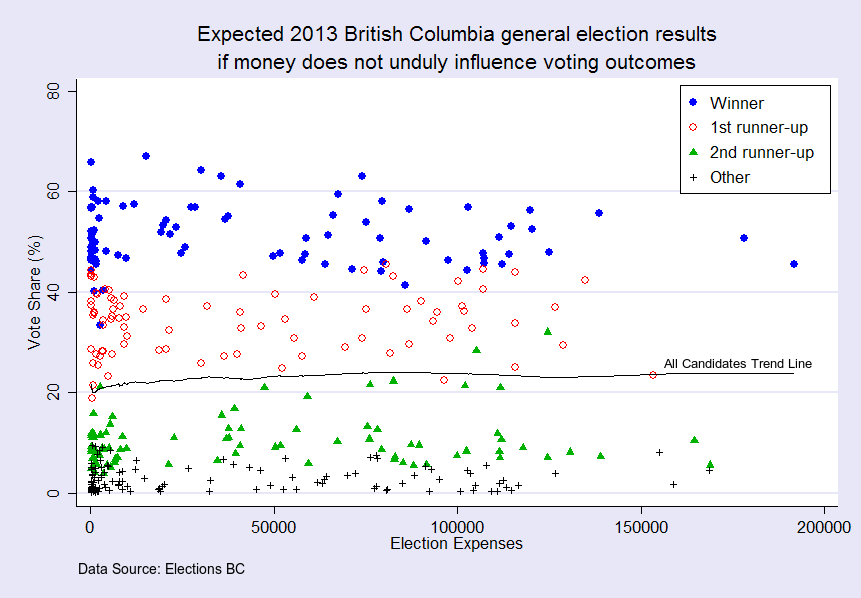
-
Ms. Clark, “Tear Down This Wall.”
[The line in quotes above is from US President Ronald Reagan’s 1987 Berlin Wall speech.]
The BC Conservative Policy Document is the Party’s contract with the British Columbian voter. According to the contract, if the Party forms a government on May 9, 2017, it will enact legislation that bans corporate and union (C&U) donations to political parties (BC Cons. Pol. Doc. art. 2, § 1, cl. 12, Feb. 20, 2016, Richmond, BC.) The BC NDP and BC Green Party leaders have also repeatedly declared that their parties will ban C&U donations. The ruling BC Liberal Party, however, refuses to end C&U donations to political parties, as this is their main source of revenue (64% of 12.5M in 2016). In a CBC Radio One interview (below), Duff Conacher of the Ottawa based Democracy Watch group states that his organization supports eliminating C&U donations to political parties, but advises that these bans are not enough. He argues that strict caps on individual donations must also be implemented alongside bans on contributions from C&Us. Mr. Conacher recommends that BC adopt Quebec’s campaign financing model. Considered by many as the gold standard for political donations, the model mandates the elimination of donations by C&Us, setting limits on individual donations at $100 per year, augmenting donations with public funding and installing other safeguards such as submitting money through legislative bodies like Elections BC. The strict $100 cap on individual contributions is needed to prevent straw–man donations by companies, unions and organized crime, that is, political donations funneled through individuals from corporate, union and organized crime interests.
We do not have to reinvent the wheel. Quebec's electoral finance model was developed out of high profile investigations (the Duchesneau Report and Charbonneau Commission) that showed years of corruption, collusion practices, influence-peddling, extensive cost overruns, manipulation of the public-tendering process, price-rigging schemes, intimidation, bribery, favoritism and kickbacks to political parties. According to Lisa Sammartino at the Dogwood Initiative, some of the corporations and executives (straw-men) responsible for Quebec’s corruption scandals are big donors to the BC Liberal Party. These corporations regularly compete for BC government contacts and the BC government often hires their former executives to run BC Crown Corporations. Adopting Quebec's election financing model is a good first step to ending government corruption in Victoria and saving BC taxpayers and businesses millions. For that to happen, we must replace the BC Liberal government on May 9, 2017.
-
Fortifying the Great Wall.
The BC Liberal Party has begun posting biweekly lists of selected information from the donations it receives. Although the BC Liberal Party argues publicly that it is doing this to increase transparency, the strategy may have other unstated goals. These include drawing attention away from major changes needed to reform election finance law and deflecting attention away from the BC Liberal government’s falsehoods, boondoggles and scandals, its transplanted war on science, its lack of leadership in the deadly fentanyl crisis, its minimal support of seniors and its tragic failures with vulnerable youth like the death of Alex Gervais. The BC Liberals may also be using “real-time” transparency to intimidate and demoralize the competition, to impress voters with the Party’s fundraising prowess, to create competition within donor groups (e.g. corporations, unions, wealthy individuals) and to pressure non-donors to donate to the BC Liberal Party. The BC Liberals plan to introduce a law that will force other parties to make the same online postings. The intent behind this action may be to publicly undermine the competing parties and force them to divert their limited resources away from the 2017 election to meet the stipulations of the new law. If we do not remove the BC Liberals from power on May 9, 2017 and overhaul our campaign finance laws, the Great BC Liberal Wall will continue to grow and democracy in BC will be further eroded.
-
Confronting Ozymandias
[The title above is based on English poet Percy Shelley’s 1818 sonnet titled “Ozymandias.” Ozymandias is a tyrant from antiquity who was obsessed with his own greatness.]
Webcasts of recent BC Legislature debates are available online. The video below is an excerpt of a 55-minute debate between BC Liberal and BC NDP MLAs that took place in the chamber of the BC Legislature on the morning of May 2nd, 2016 at the end of a 2 hour 45 minute session. An excerpt is included here because access to the full session webcast is unpredictable — technology is not one of the BC Liberal government’s strengths. The debate is about whether to take big money out of politics. Big money is another name for donations from corporations and unions (C&Us). A debate on big money is a palatable way that politicians address corruption in government. To launch an effective offense or defense against the BC Liberals and the BC NDP, it is important that we BC Conservatives know what and how the MLAs in these parties think. The BC Conservative Party is on record for declaring that it will eliminate big money from politics. Below I distill the debate arguments.
-
BC NDP MLAs want to end big money in politics. They argue that C&U donations determine who wins government contracts and lead to weak laws protecting the environment and workers. C&U donations also reduce confidence in government and increase cynicism in the political process such that some believe that democracy is for sale. These attitudes are responsible for high voter non–participation, which ranges between 40% and 50% in BC. In addition to the effects of C&Us on government decision making and voter attitudes, MLAs point out (repeatedly) that a recent survey showed 86% of adult residents in BC support a ban on donations from C&Us. They note that other provinces see BC as the Wild West in terms of our approach to fundraising and point out that the federal government and other provincial governments already have bans in place. For example, Ontario banned big money from politics after the Globe and Mail exposed that Ontario Liberal Premier Kathleen Wynne and her cabinet were meeting with corporate leaders and lobbyists for up to $10,000 and that cabinet ministers received secret fundraising quotas for as much as $500,000. Finally, MLAs for the BC NDP argue that the only reason the BC Liberals refuse to ban big money is that the Liberal Party raises most of its money from corporations.
[The “Cash for Access” comedy video below (right) is available through the David Merry Comedian Youtube Channel.]
-
The BC Liberals defend the electoral finance status-quo. Liberal MLAs point out that BC already has stringent rules in place for making donations and for spending during elections. They deny the sale of bureaucracy. They point out that “good policy is determined through best practices and consultation with stakeholders and tax-payers, not by who donated and how much they gave.” They add that decisions of the BC Liberal government often disappoint big donors. In addition to strong laws and a culture of best practices in policy development, Liberal MLAs argue that compared to the United States, there is no big money in BC. One reason for this is that BC has strict spending limits that make it pointless for an entity to raise more money than what it is allowed to spend. BC Liberal MLAs argue that if we ban C&U donations, it will open the door to taxpayers funding parties and elections. According to Liberal MLAs, “That separates parties from votes. Parties no longer have to have policies that appeal to voters, and that hurts democracy.” Finally, the BC Liberal MLAs argue that the reason the NDP wants public funding “is that their policies are so radical and ideological that they no longer appeal to working people. The NDP needs a more reliable cash-cow like the government.” As Liberal MLAs note, “That’s called milking the taxpayer.”
The debate highlights the different positions of BC Liberals and BC NDP on big money. However, the debate also gives us insights into the ways the parties attempt to influence one another. For example, in addition to identifying the negative causal effects of big money, NDP MLAs exert pressure on the Liberals to conform to the “will of the majority” by pointing out that BC lags behind most provinces in electoral finance reform and seven in eight British Columbians want to remove big money from politics. Each NDP MLA repeats the latter fact ad nauseum during the debate to intensify the pressure. By contrast, the Liberal MLAs manipulate relational triads and stigmatize the competition. In addition to creating confusion by denying the existence of big money in politics, Liberal MLAs attempt to drive a wedge between the NDP and voters wherever possible by emphasizing the costly effects of ending big money on the voter (increased taxes) and society (weakened democracy). During the debate, Liberal MLAs also label the NDP as abnormal, deviant, manipulative and desperate. Stigmatizing the competition is a strategy frequently used by the BC Liberals and its third-party advocates. Punishing critics is another BC Liberal government tactic. Some would argue that these strategies are forms of bullying, and remind British Columbians of the poignant, heartfelt words of BC Liberal Premier Clark following Amanda Todd’s death, “No one deserves to be bullied. No one earns it. No one asks for it. It isn’t a rite of passage. Bullying has to stop.” Perhaps if our political parties and their third-party advocates were better models of anti-bullying behavior, innocent people like Amanda would be alive today. Perhaps if corporations and unions stopped funding these groups, many young lives would be saved. Our leaders must have the capacity for empathy. Our leaders need to heed their own advice.
There are also similarities in how the parties debate. The MLAs of the parties rarely rebut each other’s arguments. It is possible that these parties are using the debate solely for the purpose of reconnaissance. It is also possible that these parties are in the middle of a Cold War détente that will end as we approach the dropping of the writ. The idea of a transplanted Cold War is not that far–fetched; the BC Liberals have accused some BC NDP MLAs of supporting communism. 1950s “red scare” McCarthyism is another strategy that can be added to the list used by BC Liberals to eliminate competitors. Another similarity is that most of the arguments of the MLAs are unsophisticated, poorly researched and lack imagination. It is possible that the MLAs do not have the time and resources needed to develop strong, well-informed, fact-based arguments (which do not include arguments based on Orwellian “alternative–facts” or facts that remain after the historical record has been censored for propaganda purposes). However, a better explanation is that MLAs do not care about what they say or do because they believe — thanks to big money — they are going to be re–elected anyway. Some MLAs have been in office for over two decades.
-
Provincial Capture Vs. Clean Government.
State capture is “a type of systemic political grand corruption in which private interests like powerful individuals, companies, organizations, or groups within or outside a country use their connections to significantly influence a state’s decision-making processes to their own advantage through unobvious channels, which may not be illegal” [Reworked World Bank definition]. Provincial capture is state capture at the provincial level. State or provincial capture is a problem for businesses and citizens because it can impede competition, slow economic growth, and weaken democratic institutions. The classic example of state capture is the role that a small number of Russian industrial tycoons, oligarchs, played in funding President Boris Yeltsin’s re-election in 1996 and determining federal economic policy and democracy in Russia.
Risk factors for state or provincial capture include situations where governments and businesses have very close ties, where political parties and politicians depend on private donations for financing election campaigns and where the press is not free or independent. This list is not exhaustive. Of the 12.5 million donated to the BC Liberal Party in 2016, 64% ($7,986,897) came from corporations, the rest from individuals. According to the BC NDP, almost half the money raised by the BC Liberals in 2016 came from 185 (1.7%) of 10,700 donors. A Vancouver Sun article reported that the top 50 corporate donors have given $30.6 million to the BC Liberal Party since 2005. Teck, the biggest donor at $2,818,303, has employed 11 individuals to lobby the government on climate change policy, taxation, economic development agreements with First Nations, permit fees, energy competitiveness, and solvency reserves under the Pensions Benefit Standards Act. Encana, the fourth highest contributor at $1,177,936, has 28 individuals that lobby the government on infrastructure for resource development, regulations for fracking, greenhouse gas emission policies, royalty programs and electricity rates. A follow-up Vancouver Sun article reported that many companies that donate to the BC Liberals are doing business with the BC Liberal Government. For example, Telus has donated $565,000 to the BC Liberals since 2005 and has received $750 million in provincial government business. For some companies, however, the financial exchange relationship is less transparent. The BC Liberal Government has given Hewlett Packard Advanced Solutions $886.6 million in contracts in the past ten years, but the company has only donated $4,000 directly to the BC Liberals. Lobbyists working for HP Advanced Solutions, however, have contributed over $125,000 to the BC Liberal Party.
-
Corporations and industry association lobbyists play significant roles in shaping public policy in BC. Elizabeth Denham, formerly the Registrar of Lobbyists for British Columbia, defines lobbying as “communicating for pay with a public office holder in an attempt to influence a limited number of outcomes.” The Office of the Registrar of Lobbyist (ORL) for British Columbia reports over 120,000 contacts between lobbyists and public office holders since the Lobbyist Registration Act came into force on April 1st, 2010 [Data Source: Online Lobbyist Registry search page.] 64% of these contacts have been with cabinet ministers and MLAs. The remaining 36% have been with members of government ministries (deputy ministers, assistant deputy ministers, and staff members.) In 2015, Blair Lekstrom, a former BC Liberal cabinet minister turned lobbyist, was fined $8,000 by the ORL for contraventions of the Act (investigation reports 15–5, 15–6, and 15–7)(Lobbyists Registration Act, S.B.C. 2001, c. 42, s. 3 (1)). In 2016, the agency upheld its original findings but reduced his fine to $3,000 (reconsideration reports 15–5, 15–6, and 15–7). The Table below shows the number of active registrations of in–house lobbyists (“employees of organizations who lobby on behalf of their organization”), consultant lobbyists (“individuals who, for payment, undertake to lobby on behalf of a client”), and organizations over a six–year period. Organizations include corporations and industry associations. Registrations for all three groups have increased dramatically over time. The number of in–house lobbyists has increased by 81% (1081 to 1961), the number of registered organizations has increased 78% (264 to 470), and the number of consultant lobbyists has increased 55% (370 to 573). Currently, there are 30 lobbyists for every MLA and 110 lobbyists for every cabinet minister. Deep pockets and unfettered access to our government by corporation and industry association lobbyists have profound implications for democracy and risk of provincial capture.
[Materials made available online by the federally funded Corporate Mapping Project informed the presentation of lobbying information in the paragraph above.]
Active ORL Registrations Fiscal Year In-House Lobbyists Consulting Lobbyists Organizations 2010–11 1,081 370 264 2011–12 1,595 570 377 2012–13 1,712 623 382 2013–14 1,728 635 394 2014–15 1,927 575 443 2015–16 1,961 573 470 Data Source: ORL Annual Reports
Experienced journalists suggest that ties to the BC government undermine the credibility of the mainstream media. According to Kai Nagata of the Dogwood Initiative, the owners of all print media organizations in BC and major broadcasters have donated almost exclusively to the BC Liberals. For example, Glacier Media, responsible for 27 local publications, including the Times Colonist and Burnaby Now, has donated $100,000. As well, Postmedia, an organization that oversees newspapers like the Vancouver Sun and 24 Hours, has contributed $10,000. In addition, the Rogers Group, a broadcaster responsible for City TV, VICELAND, and Macleans, has given $375,830 to the BC Liberal Party. Similarly, Shaw Communications, owner of Global News and CKNW, has donated $113,514. Mr. Nagata notes that the contribution amounts are relatively small, but they create a perception of media bias. This perceived bias increases when professional reporters take sides. US President Donald Trump complained repeatedly during his campaign that the national media was trying to rig the presidential election with its biased coverage. A recent study by The Center for Public Integrity showed that more than 96% of the $396,000US donated to the Trump and Clinton presidential campaigns by journalists, reporters, news editors and television news anchors went to Hillary Clinton. In British Columbia, the Liberal Party has announced that two journalists from Global News will be running as Liberal party candidates in the 2017 BC general election. According to political columnist, Bill Tieleman, the BC Liberal government regularly hires journalists for high-level communications jobs.
Clean government is the opposite of a captured state or province; the state or province does not depend on private interests and any business connections are transparent, equal, and mutually beneficial. Corruption is minimal in a clean government. Clean government requires election finance laws that prohibit corporate and union donations and set low ceilings (e.g., $100 per year) on individual donations. It requires laws that guarantee public funding for parties and elections (to prevent dependence on private donors), make out-of-province and anonymous donations illegal and set strict spending limits on third-party advocacy (see third–party attack ads below and the Elections BC website for a list registered third–party election ad sponsors). A clean Conservative government can fund parties and elections with money saved from making government smaller and more efficient. Significant additional cost savings will follow from overhauling a number of BC anticorruption laws already in place. To support transparency and accountability, clean government requires strong conflict of interest, lobbying registration, whistleblower protection, and freedom of information and protection of privacy laws. Under the BC Liberal government, these laws are underdeveloped. We need to close the loopholes. In the words of our neighbors in the south, specifically US House of Representatives Minority Leader, Nancy Pelosi (Democrat), and more recently, US President Donald Trump (Republican), it’s time to “drain the swamp.” Finally, clean government requires that all stakeholders adhere to a strong set of ethical principles and practices. If the BC Conservatives win the 2017 BC general election, one of the first things we will do is to conduct an inquiry into the causal relationship between donations to the BC Liberal Party and the receipt of BC government contracts. Of course, the BC Liberal Party will pay for the cost of the inquiry.
Democracy Watch and PIPE UP Network have filed a lawsuit with the BC Supreme Court to reject the approval of the Kinder Morgan Trans Mountain pipeline on the grounds that Kinder Morgan and other companies donated over $560,000 to the BC Liberal Party which could have biased the approval process and therefore created a conflict of interest. The lawsuit is not about stopping the pipeline. It is about ending government corruption. The lawsuit brings all British Columbians closer to establishing a clean provincial government. However, steps towards clean government have also been taken by political advocates like Laila Yuile when she enumerates 100s of failures of the BC Liberal government (potential consequences of a captive province), Dan Levin when he writes about BC being the “Wild West of Canadian Political Cash” in a 2017 article in the New York Times, and more recently by Dermod Travis of Integrity BC when he comments in a CBC Radio One interview (below with a CTV News story, March 6, 2017) on a Globe and Mail article about an Elections BC investigation into indirect donations given to the BC Liberal Party by lobbyists on behalf of their corporate clients. According to Elections BC, indirect donations are illegal (Election Act, R.S.B.C. 1996, c. 106, s. 186 (1) (e)). The BC Liberals blame donors for the problem. On March 10, 2017, Elections BC referred its investigation to the RCMP (CTV News story below). Shortly afterwards, on March 15, 2017, Democracy Watch called for the assignment of an independent special prosecutor to the RCMP’s investigation to prevent possible political interference (Crown Counsel Act, R.S.B.C. 1996, c. 87, s. 7). On March 30, 2017, a special prosecutor was appointed to the RCMP’s investigation. Recently, the Vancouver Sun reported that charities have donated to the BC Liberals. Political contributions from charitable organizations are illegal in BC (Election Act, R.S.B.C. 1996, c. 106, s. 186 (4)). Laila Yuile, Dan Levin, and Dermod Travis are just a few of the many individual proponents of clean government. Groups like Democracy Watch, PIPE UP Network, and the Dogwood Initiative inspire us to be better, smarter citizens.

Dermod Travis (March 6th, 2017)

Tieleman Vs. Mills (March 15th, 2017)
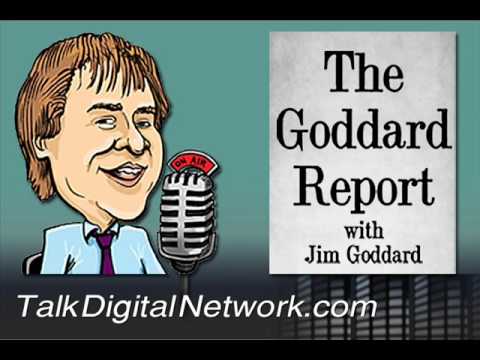
Rafe Mair (April 5th, 2017)
Walls Get Built When Good People Do Nothing.
[The line above is a variant of a statement attributed to the Irish statesman and political philosopher, Edmund Burke, by US President John F. Kennedy during his 1961 speech before the 24th Canadian Parliament.]
The plot below shows the total monthly political contributions to the Conservative, Liberal and NDP Parties over an 11-year period beginning January 2005. The data is made available through Elections BC and is limited to contributions greater than $250 during a reporting period. The BC Liberals and BC NDP raise a lot of their money six to eight months before a general election. The NDP does a significant amount of fundraising in the latter months of the year. The Liberals appear to raise money all year round. A lot of Liberal money appears to come from pay-to-play or cash-for-access fundraisers. The trend line for the BC Conservatives in the plot above is relatively flat. The BC Conservative Party does not appear to have an active fundraising program.
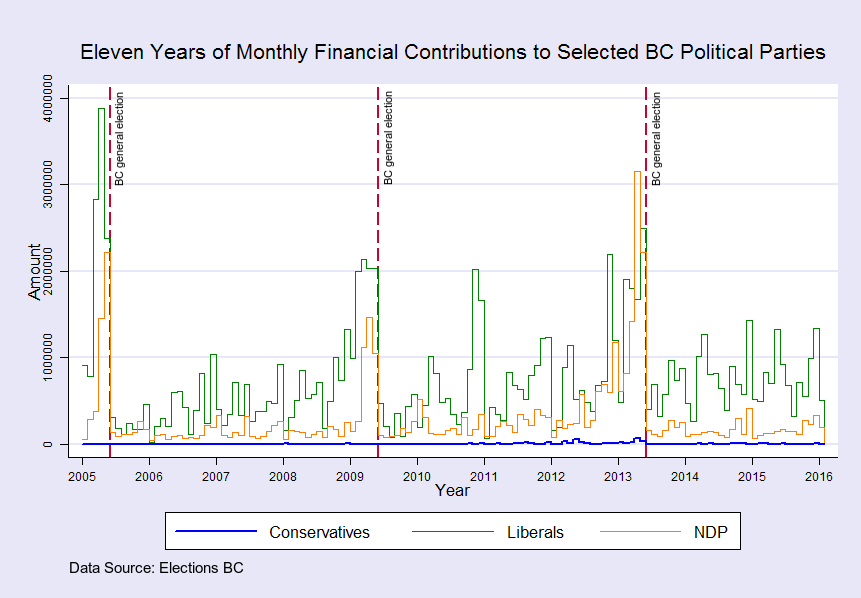
-
The Great BC Liberal Wall Is The Enemy of Freedom and Democracy.
British Columbia is moving towards a one-party system. One-party systems are vulnerable to massive illegal and legal corruption as there are no checks and balances on the powers of government. The BC NDP trend line suggests that losing the 2013 general election has weakened the NDP’s capacity to raise money. By contrast, winning the general election has had an opposite effect on fundraising for the BC Liberals. This result is predictable (see Matthew Effect). With the additional money generated as a result of their 2013 win, the Liberals may be in a position to take over NDP stronghold ridings. In fact, of almost $30 million raised by BC political parties since the 2013 general election until February 2016, eighty percent has gone to the BC Liberal Party ($23.7 million), eighteen percent has gone to the BC NDP ($5.4 million) and one fifth of one percent has gone to the BC Conservatives ($67 thousand).
My Solutions
Unless we can improve our financial situation, the BC Conservative Party will lose the 2017 BC general election and continue to lose future elections. More importantly, the Great BC Liberal Wall will continue to expand and any chance we have for restoring our broken democracy may become lost to future generations. We have a choice in the 2017 election: to capitulate and walk away or to get involved and do everything we can to bring down the Great Wall and restore BC to the great democracy it once was. As voters, we have the power to make things right. Therefore, acknowledging that bringing down the Great Wall is going to take money, I proposed the following solutions:
FIRST, develop a fundraising infrastructure for our Party that is not vulnerable to provincial capture (either full or partial capture), that can adapt to change and remain strong into the future.
SECOND, implement different fundraising strategies for individuals, labor unions and businesses. These strategies will be undertaken with the understanding that if our party is successful on May 9, 2017, contributions from labor unions and businesses will end and donations from individuals will be capped at $100 per individual per year.
Our message to voters and donors must emphasize the benefits of ending perceived corruption in Victoria before it gets beyond our control (as it did in Ontario and Quebec) and stress the importance of ensuring a strong democracy for all British Columbians. The 41st BC general election of 2017 is about the citizens of BC reclaiming the democracy that was once theirs and was taken away by the BC Liberals and a small group of corporate backers. The Great BC Liberal Wall is a blight on our democratic values. It is not who we are. It is not how we want to be remembered. We can no longer look the other way. A vote for a BC Conservative candidate on May 9, 2017 removes a huge block from the Great BC Liberal Wall and brings all of us a step closer to bringing the Wall down. A vote for a Conservative candidate on May 9, 2017 is a vote in support of restoring and securing freedom and democracy in BC for all citizens, now and for generations to come.
Problem 2: Party Recruitment Is Low
- Only 1 in 40 conservative BC voters join the BC Conservative Party.
- Consequences: conservative voters with great ideas may never receive a voice, the party cannot directly share pertinent information with these voters, and a significant amount of revenue from membership fees is lost.
Key Issues:
The party has just over 2000 members. However, 85,000 individuals voted for a Conservative candidate in the 2013 BC general election in the 56 of 85 ridings in which a Conservative candidate ran. Extrapolating to all of the 85 ridings, there would be potentially 127,000 individuals who would have or may have voted for a conservative candidate. This figure is likely an under estimation as an unknown number of conservatives voted for a liberal candidate because they did not want an NDP candidate to win. An unknown number of conservatives did not vote because they thought a conservative candidate could never win.
Keeping with this 127,000 figure, what this means is that during a BC general election period there are 127,000 – 2000 = 125,000 conservative voters (and potential volunteers and financial contributors) that the Party and its MLA candidates may not have direct access to. It also means a loss of $10 to $12.5 million in membership fee revenue between election periods (assuming $20 per person per year over a 4 or 5 year period). This membership revenue alone could support the BC Conservative Party in the 2017 BC general election. However, perhaps the greatest loss for the Party and BC are the ideas and talents of these 127,000 individuals and the significant contributions they could make to the Party and BC. This is a loss that is impossible to quantify.
Low overall recruitment rate.
We define recruitment rate as the number of active members in the BC Conservatives divided by the number of individuals who voted for a conservative candidate in the 2013 BC general election. The average recruitment rate is 2.4%. That is, for every 40 individuals that vote for a conservative candidate in the 56 ridings with a conservative candidate in the 2013 BC general election, one person joins the BC Conservative Party.
The recruitment rate is not constant.
The scatterplot below plots the number of active party members against the number of individuals that voted for a conservative candidate in the 2013 BC general election. The slope is the recruitment rate. The slope of the trendline is continually increasing (concave upwards) suggesting that recruitment gets easier as the number of conservative voters increase in a riding.
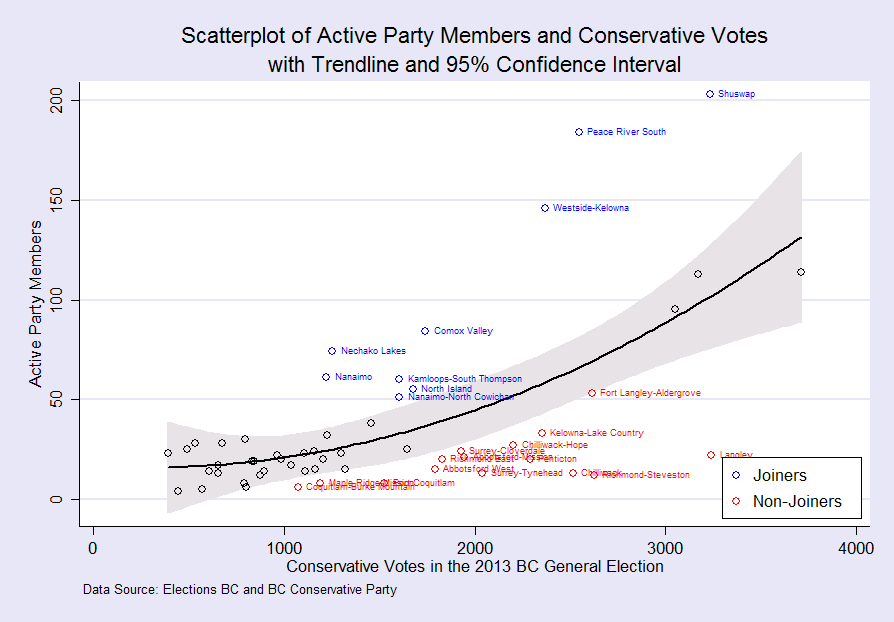
Joiners and Non-Joiners.
The recruitment rates vary widely between ridings, from 0.46 to 7.23%. The scatterplot above divides ridings outside of the trendline confidence interval into two groups: joiners and non–joiners. Joiners are ridings that have higher than expected recruitment rates. Riding–specific recruitment rates are relatively high in the Peace River (7.2%), Shuswap (6.3%) and Westside–Kelowna (6.2%) ridings. Non–joiners are ridings that have lower than expected recruitment rates. Riding–specific recruitment rates are extremely low in the Richmond–Steveston (0.46%), Chilliwack (0.52%) and Langley (0.68%) ridings.
My Solutions
If we ignore the problem, the Party will risk not engaging with the majority of conservative voters, continue to lose vast amounts of revenue, and give up control of its messaging to its critics or competitors. To prevent this from happening, I propose the following:
FIRST, grow the Party. Make member recruitment and retention the main objectives of the Conservative Party, next to fundraising. Develop a robust Conservative Party membership database. Identify and monitor key recruitment and retention metrics over time.
SECOND, build and strengthen the BC Conservative brand. Identify and improve the external perceptions of the Party and differentiate the BC Conservative Party from its competition (including the Federal Conservatives).
THIRD, study the business case for diversity and develop a diversity strategy. Write and implement a formal Diversity and Inclusion Policy for the BC Conservative Party. Translate all public and recruitment documents into other languages. Make documents available in different sizes print. Openly and meaningfully support and participate in all annual holiday parades and festivals across BC.
FOURTH, create limited-time, irresistible incentives to join the Party.
Problem 3: Party Turnover Is High
- For every five individuals that join the Party, two individuals leave.
- Consequences: The Party loses the opportunity to benefit from incredibly bright, talented, knowledgeable members who could have made a positive, long lasting contribution. It is challenging to grow a Party when almost half its members drop out: a 2000–member political party that recruits 200 new members every year but loses 80 will take 16–17 years to double its size. A high turnover rate may cause low morale, which can lead to an increase in turnover rate, which may result in even lower morale and so on.
High overall turnover rate.
We define turnover (leavers) rate as the number of expired members in the BC Conservative Party divided by the total active and expired members. The turnover rate is 41%. The retention (stayers) rate, defined as 100 minus the turnover rate, is 59%.
-
Stayers and Leavers.
Party turnover rates vary widely among the ridings, ranging from 2.1% to 82.6%. The horizontal dropline graph (below) ranks the ridings in their turnover rates after subtracting out the median. Ridings can be divided into three groups: Stayers, leavers, and ridings in between. Stayers are ridings with low turnover rates. For example, riding–specific turnover rates are extremely low in the Peace River South (2.1%), Prince George–Valemount (8.0%), and Vancouver-Fraserview (13.3%) areas. By contrast, leavers are ridings with relatively high turnover rates. For example, riding–specific turnover rates are extremely high for the Peace River North (82.6%), Kelowna–Lake Country (82.0%), and Surrey–Fleetwood (66.7%) ridings.
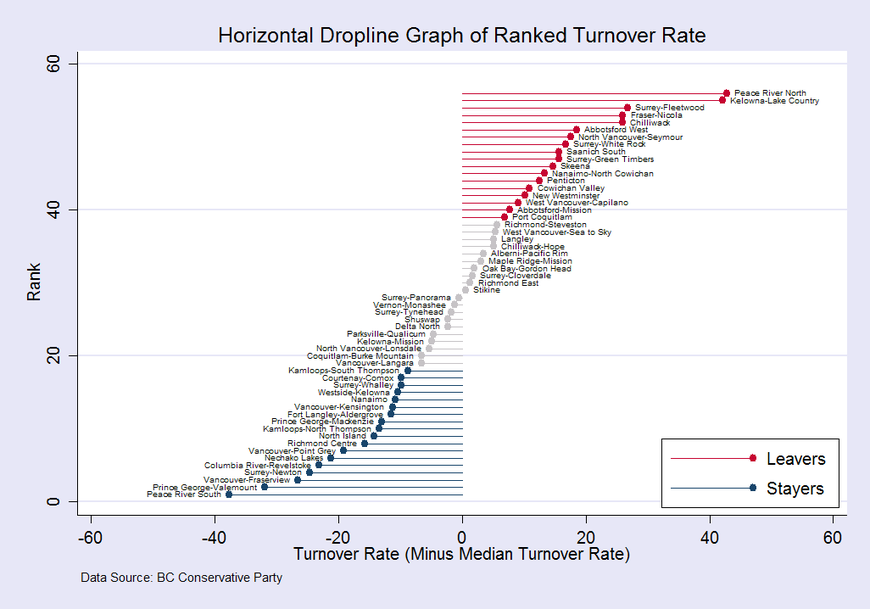
My Solutions
If we ignore the problem, the Party will continue to develop slowly, continue to bleed potentially valuable intellectual capital and remain uncompetitive. We owe it to ourselves and our fellow British Columbians not to let this happen.
FIRST, monitor key performance metrics like recruitment rate, turnover or retention rate.
SECOND, develop a member–engagement program. Conduct exit interviews to assess why individuals leave the Party. Be proactive and conduct stay interviews with Party members. Identify member talents and find a role for these members in the Party. Demonstrate and cultivate respect.
